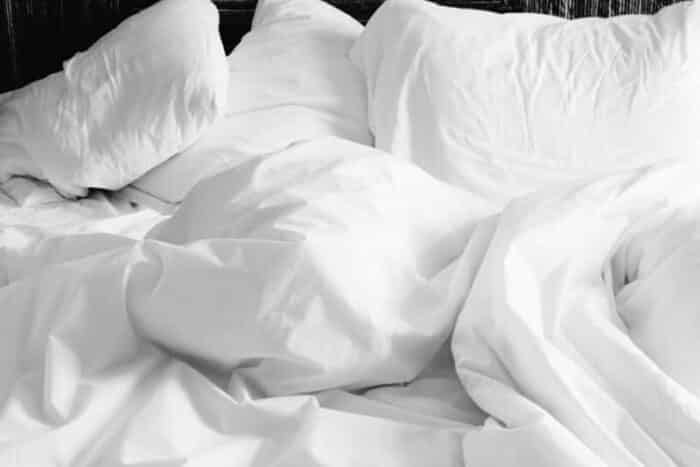Microfiber is one of the most popular materials for clothing, undergarments, and athletic wear. It’s also used in the manufacturing of handbags, shoes, and other goods that were traditionally made of leather. But is it a good choice for bedsheets?

While it’s true that microfiber sheets tend to retain heat, they are low maintenance and have a smooth, silky feel. Plus, they are wrinkle-resistant and hold their shape in the long run. However, their quality varies among brands.
But what are microfiber sheets and what makes them so popular? Are they better than cotton or silk sheets? And how long do they last? Let’s find out.
What Is Microfiber?
Nowadays, microfiber is used in thousands of products, from bedding and clothing to insulation materials. This synthetic fiber was developed in the early ’90s and has a wide range of applications across various industries.
Microfiber sheets and other products consist of thin fibers that are less than 5 millimeters in size, explains the American Association of Textile Chemists and Colorists (ATCC). This material can also be measured by a denier. Each fiber is 1 denier or smaller, according to the ATCC.
Denier is a unit of measurement used in the textile industry. It indicates the mass in grams per 9,000 meters of yarn. Based on this definition, microfiber would weigh less than 1 gram if you weighed 9,000 meters of thread.

Generally, low-denier fabrics, such as those used for bedding products, are soft and lightweight. High-denier fabrics, on the other hand, are stronger and more durable but heavier.
This synthetic material received a lot of criticism for its environmental impact. Greenpeace reports just one piece of clothing can release 700,000 microfibers during washing. These tiny fibers often end up in the ocean, affecting marine life.
Leaving these aspects aside, microfiber has several distinct advantages over other materials. Microfiber cleaning products, for instance, can reduce bacteria by 99% and prevent cross-contamination.
What Are Microfiber Sheets?
As mentioned above, microfiber is commonly used in the textile industry. Sportswear brands, for example, utilize this material for its moisture-wicking properties. Microfiber is also a good choice for underwear due to its high elasticity.
Microfiber sheets are typically made from woven strands of polyester or nylon polymers. Some manufacturers use recycled materials or wood pulp. The fabric itself is thin and lightweight but durable.

Manufacturers weave tens of thousands of microfiber threads together to create the fabric used for bedsheets. Their durability depends on the brand, points out Austin Linen Service.
This material doesn’t have the cool crispness of cotton. On the contrary, it’s silky and smooth. Plus, it often has a lower price tag than cotton, silk, bamboo, and other natural fabrics.
Cotton vs. Microfiber Sheets
Some would say that cotton is superior to microfiber, but that’s not necessarily true. High-quality microfiber sheets can provide more comfort and durability than a set of low-quality cotton sheets.
Premium cotton sheets are soft and highly breathable. Since cotton is a natural material, it’s less likely to cause allergic reactions compared to polyester and other synthetic fibers.
The downside is that cotton takes a long time to dry and doesn’t wick moisture. For this reason, it’s not the best choice for those who sweat a lot at night.

Nylon and polyester, on the other hand, are moisture-wicking fabrics that dry quickly. Their breathability depends on the yarn size and weave, explains REI. A potential drawback is that they tend to retain odors.
Microfiber sheets are also less prone to wrinkling than cotton. Plus, they feature a lightweight design. On the negative side, they can easily slip off the bed if you’re turning and tossing at night.
Microfober vs. Cotton Comparison
Let’s see other similarities and differences between the two:
- Quality cotton sheets tend to become softer and more comfortable over time. Microfiber sheets either maintain their softness or wear out as time goes by, depending on their quality.
- Both materials are easy to care for. Microfiber sheets, however, tend to absorb liquid and can be hard to clean if they get stained.
- Microfiber sheets are often more affordable than cotton sheets, but premium brands can be expensive.
- Cotton sheets take up more space in the drawer or closet because of their thickness. Plus, they tend to fluff up after you wash them. Microfiber sheets are thinner and easier to store.
Each material has advantages and drawbacks. Like with most products, you get what you pay for. High-quality sheets will offer optimal comfort and last for years, regardless of whether they are made from cotton or microfiber.
Why Switch to Microfiber Sheets?
As discussed earlier, microfiber sheets are durable and soft to touch. However, some consumers prefer the crisp feel of cotton—it’s a matter of personal preferences.

If you’re looking for wrinkle-resistant sheets, microfiber can be a good choice. This material is easy to care for and holds its shape very well. Most times, it doesn’t require ironing.
Another advantage of microfiber sheets is that they’re easy to clean. You can wash them on a normal cycle and even put them in the dryer. Just make sure you choose a quality set, as cheap microfiber sheets can shrink during washing.
Here are other potential benefits of switching to microfiber sheets:
- High durability
- Low maintenance
- Quick-drying
- Smooth, slippery feel
- Suitable for cool sleepers
- Low pilling
- Hold their color
- Some models may repel bacteria, dust mites, and bed bugs
You may have heard that microfiber sheets are prone to staining and can rip easily. Again, their quality depends on the brand and materials used.
Some types of microfiber are water-repellent, meaning that they keep moisture away. Therefore, they’re resistant to sweat and stains. Others, however, tend to absorb moisture, so they’re more prone to staining.
Potential Drawbacks of Microfiber Sheets
Despite their durability and low maintenance, microfiber sheets are not the best choice for everyone.
First of all, they trap body heat and, therefore, may not be suitable for hot sleepers.
However, their ability to retain heat can be an advantage during the cold winter months. But if you tend to warm up at night, cotton might be a better option.

Another potential drawback is their thinness. Low-quality microfiber sheets can rip easily and may not last longer than a few months.
This material also tends to produce a static charge as the fibers rub together. As a result, it may attract dust and pet hair. If you opt for microfiber sheets, you may need to wash them more often than you wash cotton or flannel sheets.
Let’s see other disadvantages of microfiber sheets:
- Increased risk of allergic reactions
- Highly flammable
- Less breathable than cotton
- May shrink after the first wash
- Not eco-friendly
Also, note that microfiber sheets should only be washed with conventional laundry detergent. Bleach, softeners, and other products can weaken the fibers, causing rips and tears. Always read the care label before washing your sheets.
Should You Buy Microfiber Sheets?
Now that we have answered your question, “What are microfiber sheets,” it’s up to you to decide whether or not this material meets your needs. Our advice is to choose a high-quality model with moisture-wicking properties.
As a final note, consider the grams per square meter (GSM) when shopping for microfiber sheets.
While the quality of cotton depends on thread count (among other factors), microfiber fabric weight is measured by GSM. The higher this number, the thicker and more durable the sheets are.

Lower quality microfiber sheets are about 55 GSM. Premium models, by comparison, are approximately 120 GSM. The latter tend to be heavy and less breathable. Consider choosing a model that’s somewhere in the middle.
In the meantime, see our guide on what thread count means. Thread count is an indicator of quality, but it’s often misused by brands as a marketing tool. We’ll show you what to watch for while shopping.
FAQ
Microfiber sheets are extremely soft and comfortable. It has a tighter weave than cotton which means that it is very durable and keeps you warm all night.
Microfiber tends to be less expensive than cotton sheets, but a 100% cotton sheet will probably have better performance than a microfiber. Cotton sheets are more breathable and help regulate body temperature, while microfiber has a silkier feel and may trap body heat.
Although microfiber sheets are thin, they often sleep warmer than cotton sheets as they tend to trap heat. This warmth can be great for chilly months or sleepers who just like to feel warm and cozy.
Citations
- Microfiber – a defined term that requires … – AATCC. (n.d.). Retrieved October 7, 2021, from https://aatcc.org/microfiber-defined/.
- About Denier. Standard Fiber. (2020, December 2). Retrieved October 7, 2021, from https://standardfiber.com/about-denier.
- Brodde, K. (2018, April 7). What are microfibers and why are our clothes polluting the oceans? Greenpeace International. Retrieved October 7, 2021, from https://www.greenpeace.org/international/story/6956/what-are-microfibers-and-why-are-our-clothes-polluting-the-oceans/.
- Microfiber factsheet – deohs home. (n.d.). Retrieved October 7, 2021, from https://deohs.washington.edu/sites/default/files/brochures/microfiber-factsheet.pdf.
- Choosing your sheets: Cotton vs. microfiber. Austin Linen Service. (2020, July 8). Retrieved October 7, 2021, from https://austinlinen.com/choosing-your-sheets-cotton-vs-microfiber/.
- Textile contact dermatitis. Textile contact dermatitis | DermNet NZ. (n.d.). Retrieved October 7, 2021, from https://dermnetnz.org/topics/textile-contact-dermatitis.
- Solved! what is microfiber? Bob Vila. (2021, February 11). Retrieved October 7, 2021, from https://www.bobvila.com/articles/what-is-microfiber/.
- Electrostatic force. Decitex. (n.d.). Retrieved October 7, 2021, from https://www.decitex.com/en/microfiber/41-electrostatic-force.



